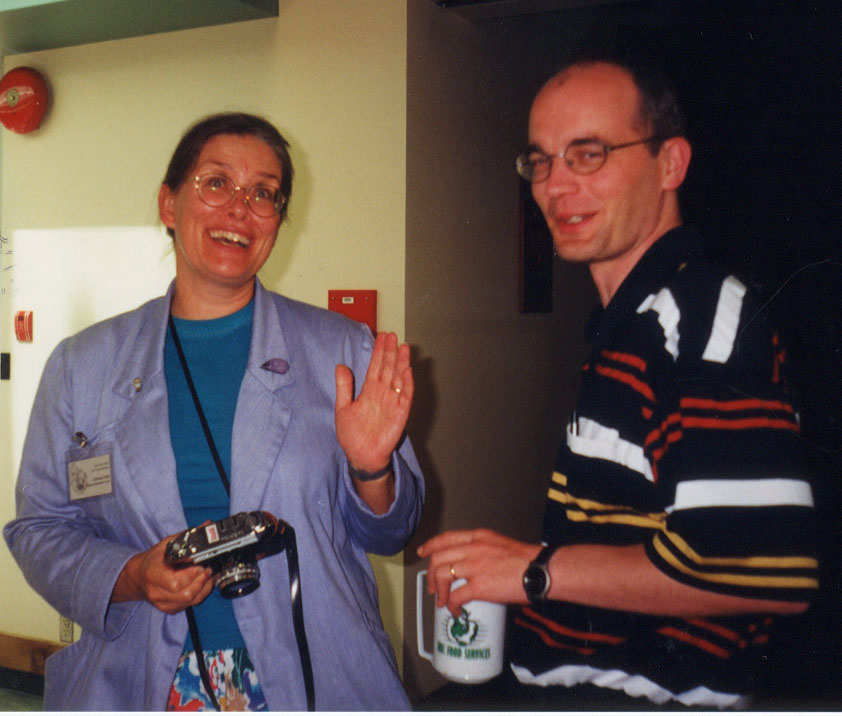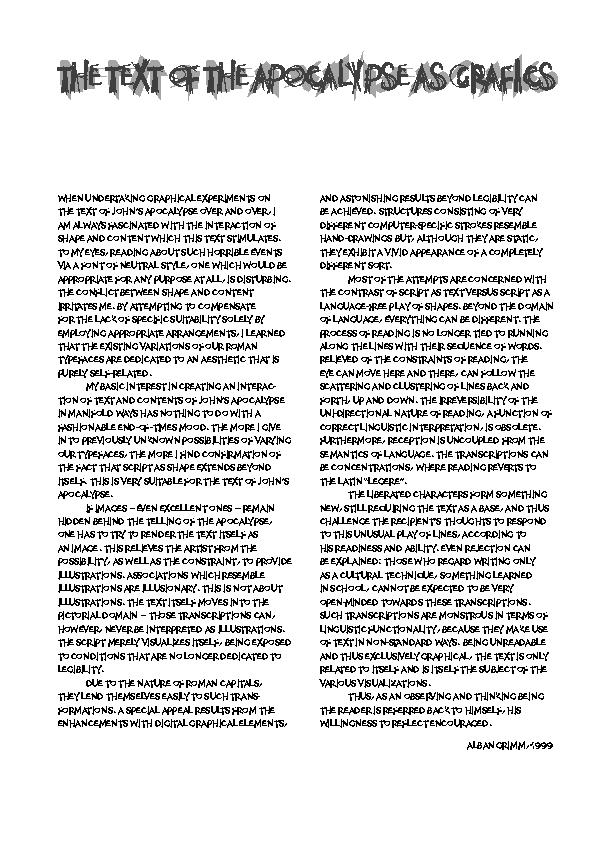


The Alban Grimm exhibit, `Text of the Apocalypse as Graphics,' displayed at the recent TUG'99 meeting in Vancouver, shows what happens when a typographer-cum-graphic artist is introduced to computer programs and finds that inputting code can lead to outputting incredible visual results.
 At the urging of his son, Gerhard,
Professor Alban Grimm
first
encountered TEX and METAFONT via AmigaTEX, so that
Gerhard's thesis in electrical engineering might be typeset.
Browsing through the TEXbook and the METAFONT book,
the professor recognized the vast possibilities that TEX offered
for his own field of work - and he was motivated enough that he
even attempted to overcome the language barrier while studying
those books. Several months later, he meet Frank Mittelbach for the
first time (summer of 1990).
At the urging of his son, Gerhard,
Professor Alban Grimm
first
encountered TEX and METAFONT via AmigaTEX, so that
Gerhard's thesis in electrical engineering might be typeset.
Browsing through the TEXbook and the METAFONT book,
the professor recognized the vast possibilities that TEX offered
for his own field of work - and he was motivated enough that he
even attempted to overcome the language barrier while studying
those books. Several months later, he meet Frank Mittelbach for the
first time (summer of 1990).
One of Prof. Grimm's aims was to study the nature of computer-generated type. That is, a hand-made type has the look and feel of hand-made type; if one used a chisel, characteristics specific to chisels would be apparent. So--can one extend this idea and identify features of truly computer-generated type (in contrast to type generated with the computer but emulating other methods)? The ``VN'' set of font variations which resulted were inspired by a search for a font to set the biblical text, The Apocalypse by St. John.1
 It was Frank who suggested that an exhibit of this melding of computer
code and graphic genius be held at TUG'99. We are therefore deeply
indebted to him for provoking Prof. Grimm with METAFONT, and for
making the arrangements to bring over from Germany the enormous folder
containing these posters (a weight of over 10kg!). Fortunately, Wendy
McKay and Ross Moore (also responsible for the TUG'99 web pages) were
able to pick up both Frank and the folder from the airport--Frank
probably thanks them even more than we do!
It was Frank who suggested that an exhibit of this melding of computer
code and graphic genius be held at TUG'99. We are therefore deeply
indebted to him for provoking Prof. Grimm with METAFONT, and for
making the arrangements to bring over from Germany the enormous folder
containing these posters (a weight of over 10kg!). Fortunately, Wendy
McKay and Ross Moore (also responsible for the TUG'99 web pages) were
able to pick up both Frank and the folder from the airport--Frank
probably thanks them even more than we do!
The exhibition comprised 7 sets of panels, each set being the full text (in German) of the Apocalypse. Some sets had 22 graphic pages, while others only 11, where two chapters were set on one page. In all, 132 panels were displayed, with Frank putting up a different set each morning and afternoon, with assistance from Anita Hoover, program co-chair and technical editor of the proceedings.
In addition, several texts written by Prof. Grimm provide some background to the whole project. The texts had been translated by Prof. Grimm's son, Gerhard, and edited by Christina Thiele, proceedings editor.
 To describe the images in this exhibit is nigh impossible. Almost.
Imagine a large off-white poster-sized panel, with two main areas of
`stuff' rendered in varying combinations of black, red, blue, yellow,
... . The upper area shows material that is text (it just doesn't
look like text), while the lower area (in the early series) is clearly
an all-caps text. The graphics on top of each page were generated from
the first and last sentences of the current chapter, which appears in
the lower area (either on one page or two). The difference in
presentation is the result of selecting appropriate METAFONT
modifications.
To describe the images in this exhibit is nigh impossible. Almost.
Imagine a large off-white poster-sized panel, with two main areas of
`stuff' rendered in varying combinations of black, red, blue, yellow,
... . The upper area shows material that is text (it just doesn't
look like text), while the lower area (in the early series) is clearly
an all-caps text. The graphics on top of each page were generated from
the first and last sentences of the current chapter, which appears in
the lower area (either on one page or two). The difference in
presentation is the result of selecting appropriate METAFONT
modifications.
The transformations are TEX and METAFONT in action, but not with results we've ever seen before! Some of the series do need to be seen together, as the gradual change in color and presentation of graphics adds to the visual effect, something an individual poster--though beautiful--simply does not hint at, when seen in isolation.
A glimpse of this unique exploration of TEX and METAFONT will appear in the TUG'99 proceedings--although black and white reproductions cannot fully do justice to the work. But before that, we have colour samples for you to view right here.
Prof. Grimm generously allowed all his prints for this exhibit to be given away to the participants at TUG'99. We would like to express our thanks--and our amazement--to Prof. Grimm, for having shown us that paper and ink can go far beyond `boxes and glue'.